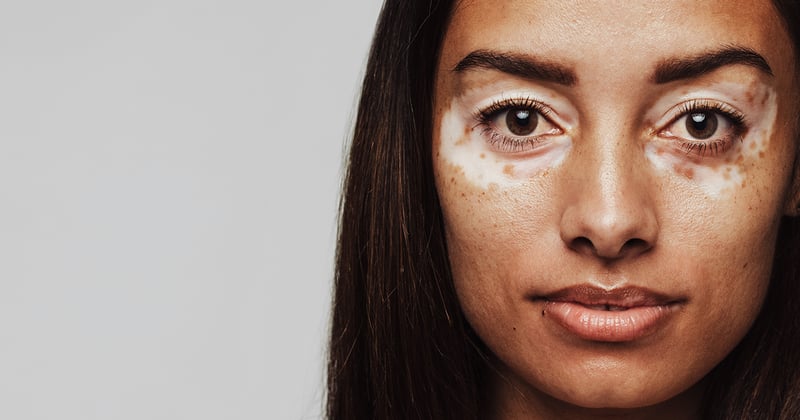

Vitiligo
in Viera, FL
What Is Vitiligo?
Vitiligo is a skin disorder that causes skin to lose its pigmentation. In place of color, your skin develops smooth, white areas called macules (if less than 5 millimeters in size) or patches (if 5 millimeters or larger). If you have vitiligo in a place on your body that has hair, the hair may also turn white.
Vitiligo typically begins in your 20s (although it can happen at any age) and first appears on the face, hands, forearms, or feet. The size and number of patches vary from person to person. However, the condition tends to progress over time, with larger and more areas of the skin losing pigment.
REQUEST NOWAre There Different Types of Vitiligo?
Generalized vitiligo is the most common type, involving loss of pigment in patches of skin all over the body. With segmental vitiligo, smaller patches appear on one side of the body in a limited area. People with universal vitiligo lose most of their skin color entirely, although this type of vitiligo is rare.
What Causes Vitiligo?
Vitiligo is generally considered to be an autoimmune disorder, which occurs when your immune system turns on itself and attacks your own tissues and organs. With vitiligo, the immune system targets your skin’s pigment cells (also called melanocytes). As many as 25 percent of people with vitiligo have at least one other autoimmune disorder.
Certain genetic factors also increase your chances of getting vitiligo. About 30% of vitiligo cases run in families.
What Are the Challenges of Living with Vitiligo?
Vitiligo patches do not affect a person’s general health, but their emotional health is another matter. People with vitiligo may feel embarrassed, anxious, or depressed about their skin, especially if others stare or make insulting comments.
The contrast between someone’s natural skin color and their vitiligo patches is greater when they have a darker skin tone. Concerns about appearance and ethnic identity are common, especially for darker-skinned individuals. Having a more even skin tone and fewer vitiligo patches can greatly improve a person’s mental well-being.
Are There Treatment Options for Vitiligo?
Some people with vitiligo rely on makeup or self-tanner products to cover their patches. Thankfully, Forefront Dermatology offers many treatments that can help restore your lost skin color and prevent vitiligo from spreading to other areas.
What Types of Vitiligo Treatment Can a Dermatologist Provide?
If you see any light-colored spots or patches on your skin, visit your Forefront dermatologist. During your exam, we may use a Wood’s lamp, which is a specialized lamp that clearly identifies areas of vitiligo.
The goal of vitiligo treatment is to create a uniform skin tone, either by restoring your skin color (pigmentation) or eliminating the remaining color (depigmentation). Your treatment options include:
• Pigmentation therapy – Corticosteroids and other medications are used orally (as a pill) or topically (as a cream) to restore skin tone
• Laser therapy – Lasers that emit ultraviolet (UV) light can treat targeted areas
• Phototherapy – Exposes your skin to UV light for a set period of time
• Skin graft surgery – Skin is taken from one part of the body and used to cover another
• Cell transplant surgery – Cells from healthy, pigmented skin are placed into skin with vitiligo
• Camouflage therapy – A combination of sunscreen, makeup, hair dyes (if vitiligo affects your hair or scalp), and medications that help camouflage the patches
No treatment works for everyone, but your Forefront dermatologist can tell you what options would likely work best for you.
Can I Stop the Spread of Vitiligo?
Sun protection is extremely important for stopping the spread of vitiligo. Because there’s no pigment to protect the skin from the sun’s rays, people with vitiligo burn easily. A bad sunburn can worsen vitiligo, as can sun-induced darkening of the surrounding skin.
Therefore, people with vitiligo should:
• Avoid tanning
• Seek shade whenever possible
• Use sunscreen with an SPF of 30 or higher
• Wear sun-protective clothing
How Do I Schedule Vitiligo Treatment?
Our caring, compassionate team of board-certified dermatologists is ready to help you. All you have to do is contact us. Find a Forefront Dermatology office near you and schedule a consultation today.
Got vitiligo? You’ve got options. Book a consultation with a skin care expert today.
1 Location in the Viera, FL area
Interested in Vitiligo? Request a consultation with a skin specialist today.
*Treatment options may vary at each location.Please confirm your desired treatment is offered at your preferred location when scheduling. *Age Restriction.
For patients scheduling who are under 18 years of age (19 in Alabama) please make sure you have permission from your parent or legal guardian to schedule this appointment. Your parent or legal guardian must accompany you on your initial visit and on certain subsequent visits to provide appropriate informed consent.